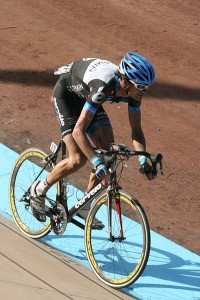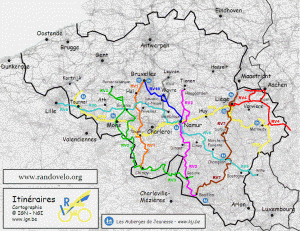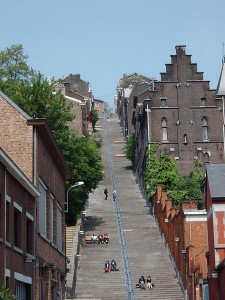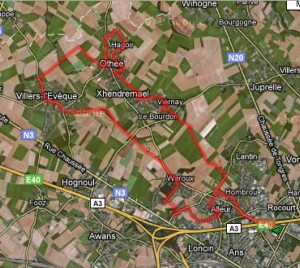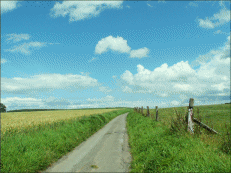The Race: Liège-Bastogne-Liège

Liege-Bastogne-Liege race course. The blue line is from Liege to Bastogne, and the red line is from Bastogne to Ans.
This Sunday, April 24th, will be the 97th edition of Liège-Bastogne-Liège. This race is an out-and-back course, 161 miles total: the first leg, from Liège to Bastogne is approximately 65 miles, and the return leg is approximately 96 miles, with most of the long, steep climbs coming in the final 60 miles of the race. Until 10 years ago the race was a true loop, finishing in the Liège city-centre, but in 1992, the finish was moved to the suburb of Ans. Moving the finish allowed the race to end on a 1-mile climb up the Côte de Saint-Nicolas. (The côtes – 11 in total – in Liège-Bastogne-Liège are the equivalent of the Tour of Flanders’ bergs).
Liège-Bastogne-Liège is known more for its brutal climbs than its cobbles. While there are a few rough sections, cycling’s oldest race (first held in 1892) has made its way onto modern roads. As we have seen the past couple of weeks, riding on cobbles is challenging because the uneven surface causes mechanical problems and crashes. At Liège-Bastogne-Liège, the challenge is hanging in for the final 60 miles of climbing. Often a rider or group of riders will try to distance itself from the peloton either on or just prior to one of these climbs.
A Quick Update on Paris-Roubaix
Two weeks ago, we were in France at Paris-Roubaix. With favourite (and 2009 champion) Tom Boonen out of the race (after a mechanical problem and a crash), Johan Van Summeren of Team Garmin-Cervelo was able to ride away from the lead pack of riders to finish solo, crossing the finish line in the Roubaix velodrome a full 19 seconds ahead of last year’s winner, Fabian Cancellara, who finished second.
Travelling with your Folding Bike
Since there has been a full two weeks between races, there is ample time to ride between Roubaix and Liège, even riding only a few hours every day. The total distance is about 125 miles, so with 2 hours of fairly leisurely riding, it would be possible to make it from Roubaix to Liège in only 3 or 4 days. There is a network of bike routes throughout the French-speaking region of Belgium. You can start in Lille, just south of Roubaix in France, and ride east to Liège – you can choose your route depending on how long you want to ride each day and which cities you want to see. And, of course, if you didn’t want to ride through the countryside you can always just take your folding bike as a piece of luggage on the train.
Taking in the Sites
While Liège is home to one of the biggest one-day races on the pro cycling calendar, it is also an industrial city, and has its fair share of pollution and traffic. Because of the steep hills, if you’re going to be staying in Liège, you might want to leave your folding bike in your hotel for a few days and take in the sites on foot (like this giant staircase – the 406 steps of the Montagne de Bueren), or on public transportation. Of course, if you’re going to be taking public transportation, you can always take your folding bike along, just in case. (Or you can take the bus uphill and ride on the way down – I just wouldn’t recommend riding down that staircase!).
There are also good opportunities for both mountain biking and road riding just outside the city – there are routes of different lengths suitable for cyclists of all abilities. Many of these are loops that begin and end in Liège, and depending on where you’re staying, you might have to ride through the city to get to the start of your route; it might be easier to bus it to the start of the route with your folding bike than to brave some of the hills in Liege. It’s also worth noting that Liège is surrounded by hilly terrain, and even “easy” rides feature substantial hilly sections. Although the riding will be more pleasant out of the city and away from traffic, you’ll still be in for a good workout.
If you’re going to be touring southern Belgium with a Montague folding bike, you’ll definitely want one with gears – if you’re going to be riding mostly paved roads, the Navigator or the Fit would be a good choice, and if you’re thinking of doing some trail riding, you might consider the Paratrooper or the Paratrooper Pro. There’s also some seriously hilly riding on the way from Roubaix to Liège. If you’re concerned about being able to tackle the hills, you might be most comfortable on a mountain bike because Montague’s folding mountain bikes, like most mountain bikes, are geared lower than pavement bikes. And because Montague folding bikes have full size wheels, it’s easy to find a set of narrower semi-slick tires for your mountain bike if that’s what you prefer.
Where Have You Travelled?
Have you done any bicycle touring? How was the trip? Did you run into any unexpected terrain or weather? What’s the longest you’ve ridden in a day? Or the steepest hill? We’d love to hear your stories.

